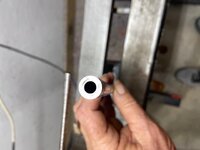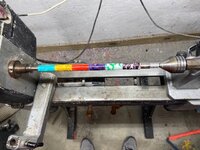I usually make pens in semi large batches, at times up to 100 in a batch. I have found that it is easier to turn all of them, usually on between centers bushings, then sand all of them. For sanding I make sanding mandrels to do multiples at once. I usually use an aluminum tube, wood dowel or derlin rod for a mandrel. I make the mandrel slightly smaller in diameter than the ID of the tube and long enough to load 4-7 pen sections at once for sanding. I cut tubes to short lengths to serve as spacers. It doesn't matter if the fit is not tight like a turning bushing, I just use them for sanding.
I want to cut threads on some of the more used mandrels so that I can screw a nut on to lock it down firmly. Finally, I'm getting to the question I'm here to ask. I have a foot long 1/2 inch thick wall aluminum tube, about .26 ID, just enough for a standard mandrel to slide inside. I want to cut threads in the 1/2 in rod/mandrel and I don't know much about thread cutting. Do I use a 1/2 in die and will that take a 1/2 inch nut? It seems like a bigger die and nut might be needed, I don't want to buy the wrong size die.
I want to cut threads on some of the more used mandrels so that I can screw a nut on to lock it down firmly. Finally, I'm getting to the question I'm here to ask. I have a foot long 1/2 inch thick wall aluminum tube, about .26 ID, just enough for a standard mandrel to slide inside. I want to cut threads in the 1/2 in rod/mandrel and I don't know much about thread cutting. Do I use a 1/2 in die and will that take a 1/2 inch nut? It seems like a bigger die and nut might be needed, I don't want to buy the wrong size die.


